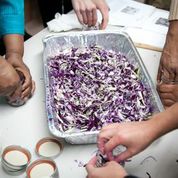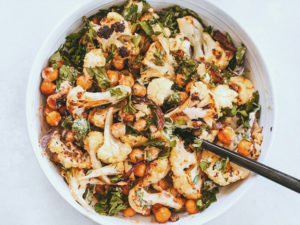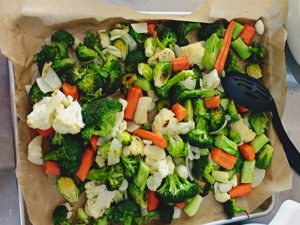Homemade Sauerkraut
Jennie, the BSCAH Urban Farm Manager, taught us about the health benefits of fermented foods and showed us how to make sauerkraut at Health 360 on Friday, April 12th. What is fermentation?
Fermentation is the process in which bacteria and yeasts feed on the sugars in food. This process creates lactic acid, a plant-based and naturally occurring preservative. Fermented food contains probiotics, which means they contain healthful bacterias that help our bodies digest food. Different cultures have been fermenting food for thousands of years. Many everyday food items are fermented like bread, coffee, wine and beer, yogurt, chocolate, soy sauce, and pickles. Fermentation uses the air around us to make our food more digestible and delicious! It’s raw and alive! And, it’s so easy!
Here are quick and simple instructions to make delicious sauerkraut, fermented cabbage. You can use sauerkraut in sandwiches, salads, eat right out of the jar, and anything else you might think of. This recipe uses green and red cabbage, but you can choose just use one, or any other hearty vegetable you want. I like the color of the two mixed together. The joys of fermentation are that it truly is endless. Try anything! Get experimental!
*According to the Journal of Agricultural and Food Chemistry, fermentation breaks down glucosinolates in cabbage into compounds called isothiocyannates, which are already known to fight cancer!
Sauerkraut
Timeframe:
1 to 4 weeks (or more)
Materials:
Cabbage (as much as you want)
Jar (as big or as small as you want)
Salt (as much as you want, about 1 tablespoon per pound of cabbage)
Cheesecloth or other porous/light fabric
Large bowl
Hands!
*Fermentation, like all great art forms, does not require exact measurements. Feel free to figure out what ratios you like best.
Process:
- Chop or grate cabbage, finely or coarsely, with or without hearts, however you like it. *We are using red and green, which usually comes out bright pink!
- Sprinkle salt on the cabbage you go. The salt pulls water out of the cabbage (through osmosis), and this creates the brine in which the cabbage can ferment and sour without rotting. The salt also has the effect of keeping the cabbage crunchy, by inhibiting organisms and enzymes that soften it.
- You can include other vegetables and spices if you like – carrots, radish, garlic, onions, brussels sprouts, caraway seeds, juniper berries, dill, celery seeds. Anything will work.
- Mix all ingredients together in large bowl.
- Begin to pack your kraut into a vessel of your choice. Glass jars or ceramic crocks work best. Pack your vessel by pushing down on the cabbage as much as possible to release water. When it is filled to capacity with a half an inch or so of brine at the top, place cheesecloth around the lid and put a rubber band around it or a plate on top, to keep dust out of it.
- Every day, take a look at it. Taste it. Taste and see what’s happening. Figure out what stage you like it best. Make sure there’s always brine at the top. If there isn’t, push down the cabbage to create more. You can continue this process for two days, then just put it in the fridge with a lid, or a week, two, or three! At any stage if you do not want to check on it, put a lid on it and put it in the fridge. It’ll last for months and continue to ferment!
If any moldy or scummy looking stuff develops on the surface, don’t worry about it. Just wipe it off with a clean paper towel.
Enjoy!
Thank you to Sandor Katz for all this great information!
Photo by Murray Cox, http://www.murraycox.com/.





